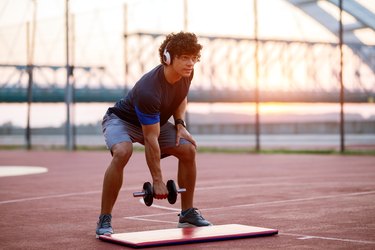
When you think of explosive strength exercises, your mind likely goes straight to body-weight plyometric moves like box jumps and burpees.
And while these exercises are sure to work your body, if you have a dumbbell handy, using it can be even more beneficial.
Video of the Day
Explosive strength training with an external load like a dumbbell is a highly effective way to maximize how much force your muscles can quickly produce, says Anthony Crouchelli, CPT, founding trainer of Grit Bxing in New York City. That's critical if you want to run faster, jump higher or improve your overall workout performance.
But this type of training isn't just for the gym. Anyone looking to make everyday tasks easier can benefit. Think about hoisting a heavy tote of groceries over your shoulders or pick up a child. These aren't slow and controlled movements. They require power.
They also require strong, powerful and elastic connective tissues, which explosive strength training helps build. And by doing so, power training can help reduce your risk of injury both in your workouts and everyday life, Crouchelli says.
Doing power-based resistance training is even associated with a lower risk of falls and disability in women 60 and older, per an often-cited November 2008 Scandinavian Journal of Medicine & Sciences in Sports study. Explosive training is particularly great for older adults because it activates the power-based muscle fibers that can otherwise decline with age, according to the American Council on Exercise (ACE).
To help you build strength, power and lean, functional muscle, Crouchelli offers the best exercises for building explosive strength.
The best part? To do them, all you need is a single dumbbell.
Move 1: Single-Dumbbell Deadlift
- Stand with your feet hip-width apart and hold the dumbbell in your right hand at arm's length. Extend your left arm to the side to help stabilize your body. Squeeze your shoulder blades back and down to engage your lats. Brace your core.
- Hinge your hips behind you so that your shoulders are above your hips, and your hips are above your knees.
- Keeping your feet firmly planted on the ground, quickly drive through your legs to stand up tall.
- Do all reps, then repeat on the other side.
Move 2: Single-Dumbbell Snatch
- Stand with your feet hip-width apart and hold the dumbbell in your right hand at arm's length. Extend your left arm to the side to help stabilize your body. Squeeze your shoulder blades back and down to engage your lats. Brace your core.
- Hinge your hips behind you so that your shoulders are above your hips, and your hips are above your knees.
- Keeping your feet firmly planted on the ground, quickly drive through your legs to "float" the dumbbell up to shoulder height. (This is called a high pull.)
- Quickly flip your elbow underneath your shoulder and press the dumbbell overhead.
- Pause, then bring the dumbbell back to the starting position.
- Do all reps, then repeat on the other side.
Tip
During the high pull, make sure you're keeping the weight close to your body as if you're zipping up your coat.
Move 3: Single-Dumbbell Hang Clean
- Stand with your feet hip-width apart and hold the dumbbell in your right hand at arm's length. Extend your left arm to the side to help stabilize your body. Squeeze your shoulder blades back and down to engage your lats. Brace your core.
- Squat down to lower the dumbbell just past your knees, then drive explosively through your legs to "float" the dumbbell up to your shoulder. Be sure to keep your heels down on the floor until your knees and hips fully extend.
- Finish with your elbow pointed down and the dumbbell resting in front of your shoulder. (This is called a front rack position)
- Pause, then lower the dumbbell back to the starting position.
- Do all reps, then repeat on the other side.
Move 4: Single-Dumbbell Hang Clean to Squat
- Stand with your feet hip-width apart and hold the dumbbell in your right hand at arm's length. Extend your left arm to the side to help stabilize your body. Squeeze your shoulder blades back and down to engage your lats. Brace your core.
- Squat down to lower the dumbbell just past your knees, then drive explosively through your legs to "float" the dumbbell up to your shoulder. Be sure to keep your heels down on the floor until your knees and hips fully extend
- From the front rack position, lower into a squat.
- Press through your heels to stand back up and then lower the dumbbell to your side to return to the starting position.
- Do all reps, then repeat on the other side.
Move 5: Single-Dumbbell Burpee to Snatch
- Lie on your stomach with your hands by your chest and hold the dumbbell on the floor with your left hand. Extend your legs behind you, tucking your toes on the ground.
- Keeping your entire body tight and core engaged, press your body up in one straight line to get into a high plank.
- Next, jump your feet forward to the outside of your hands to get into a squat. Extend your left arm to the side to help stabilize your body.
- Drive explosively through your legs and press the dumbbell overhead.
- Pause, the lower the dumbbell back to the starting position.
- Do all reps, then repeat on the other side.
Tip
For a low-impact variation, walk your feet toward your hands instead of jumping your feet forward.
Was this article helpful?
150 Characters Max
0/150
Thank you for sharing!
Thank you for your feedback!